Habitats
Akrotiri Peninsula is the largest wetland system in Cyprus and its importance lies on its mosaic characteristics, which include coastal scrubs, saltmarshes, dunes, phrygana, meadows, Mediterranean forests of junipers, eucalyptus forests, agricultural areas, grazing marshes, reedbeds and impressive coastal cliffs. A seasonal Salt Lake occupies the centre of Akrotiri Peninsula and it is the main part of a wider aquatic system with several saline, blackish and freshwater habitats.
The shores on the west side of the Peninsula are exposed to prevailing westerly winds and waves and exhibit the ecological characteristics of exposed and semi-exposed shores, comprising mainly of shingle beaches. The south coast of the peninsula is mostly rocky with high cliffs and partially submerged sea caves, and the eastern coast is sandy. The main wetland habitats around the Salt Lake include communities of conservation importance, such as the Mediterranean salt meadows and the Mediterranean halophilous scrubs. The main forest north of the Salt Lake is primarily composed of planted non-native species, mainly acacia and eucalyptus.
The marine area of Akrotiri Peninsula is of equal importance, as it is one of the most pristine and valuable marine areas, not only in Cyprus, but within the Mediterranean Sea. Research studies of Akrotiri marine environment indicate the diversity of its coastal and marine habitats, ranging from seagrass beds to sand dunes, sea cliffs and rocky reefs to remote submerged sea caves. Akrotiri supports healthy meadows of the endemic seagrass Posidonia oceanica. In the area we can also find Cymodocea nodosa seagrasses and shallow reefs covered with canopy forming Cystoseira species, coralligenous communities and sponges. The submerged sea caves at Akrotiri cliffs provide one of the last remaining breeding refuges of the endangered Mediterranean monk seal (Monachus monachus) on the island and coastal habitats include nesting beaches of the endangered Green turtle and Loggerhead turtle.
Overall, 27 natural habitats, of which 22 are terrestrial and 5 are marine, have been recorded at Akrotiri.
Marine Habitats
1120
Posidonia beds: This habitat is characterised by the presence of the marine seagrass Posidonia oceanica which is endemic to the Mediterranean. It is a key ecosystem supporting a vast and wide diversity of species including algae, molluscs, crustaceans, polychaeta, sponges, echinoderms, fish as well as marine reptiles like green turtles. The Posidonia leaf litter accumulated on beaches is the basis of a complex invertebrate food web, acts against erosion and helps dune formation further inland. The Posidonia beds occur around most of the Akrotiri peninsula, except the north-western part.
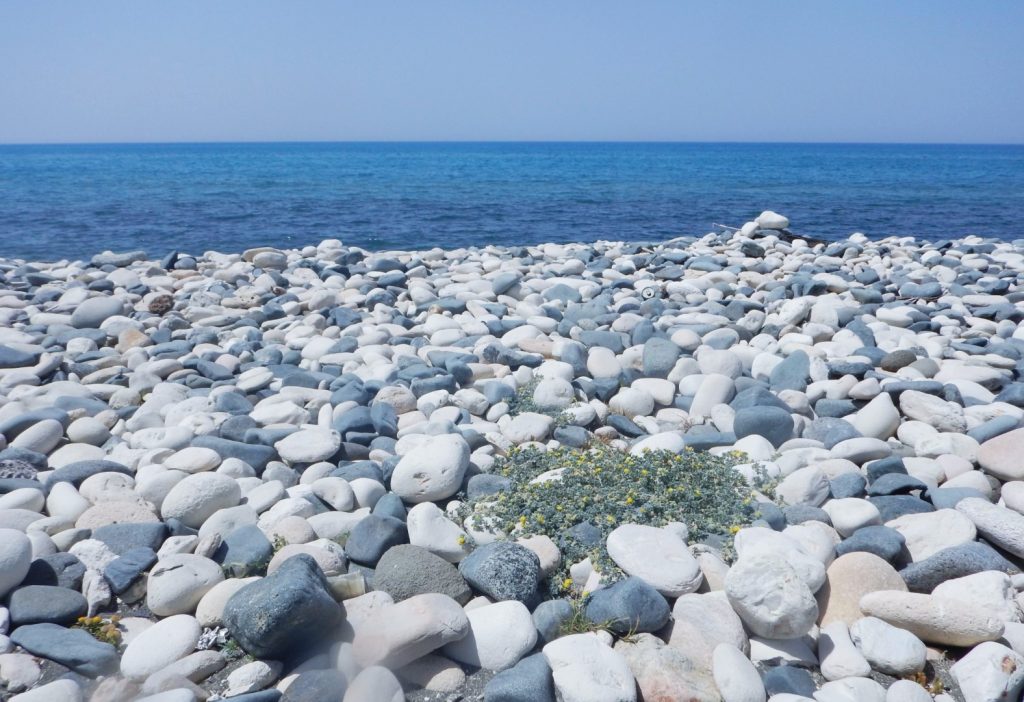
1150
Lagoons: Lagoons are expanses of shallow coastal salt water. The main plants are Ruppia maritima and Chara spp. This habitat includes the Salt Lake and the surrounding depressions. Unicellular algae are also present in the Salt Lake.
1110
Sandbanks slightly covered by the sea all the time: This habitat is characterised by sublittoral sandbanks, permanently submerged. The main species is Cymodocea nodosa. These sandbanks stretch along the sandy beaches of Akrotiri at depths between 0 and 10 metres.
1170
Reefs: Reefs are rocky marine habitats or biological concretions that rise from the seabed, they are very variable in form and in the communities that they support. Reefs at Akrotiri peninsula are found in the south.
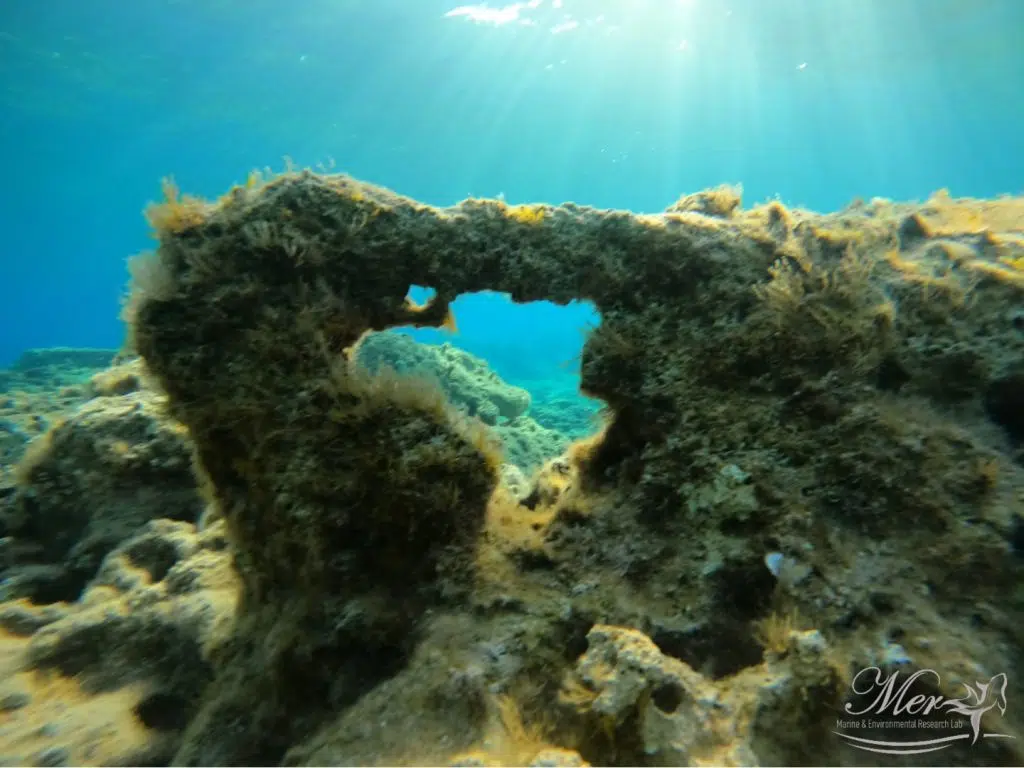
8330
Submerged or partially submerged sea caves: This habitat includes submerged sea caves and partially submerged caves which are only exposed to the sea at high tide. Caves vary in size, from only a few metres to more extensive systems. This habitat is also found along the southern coast of the peninsula between Cape Gata and Cape Zevgari.
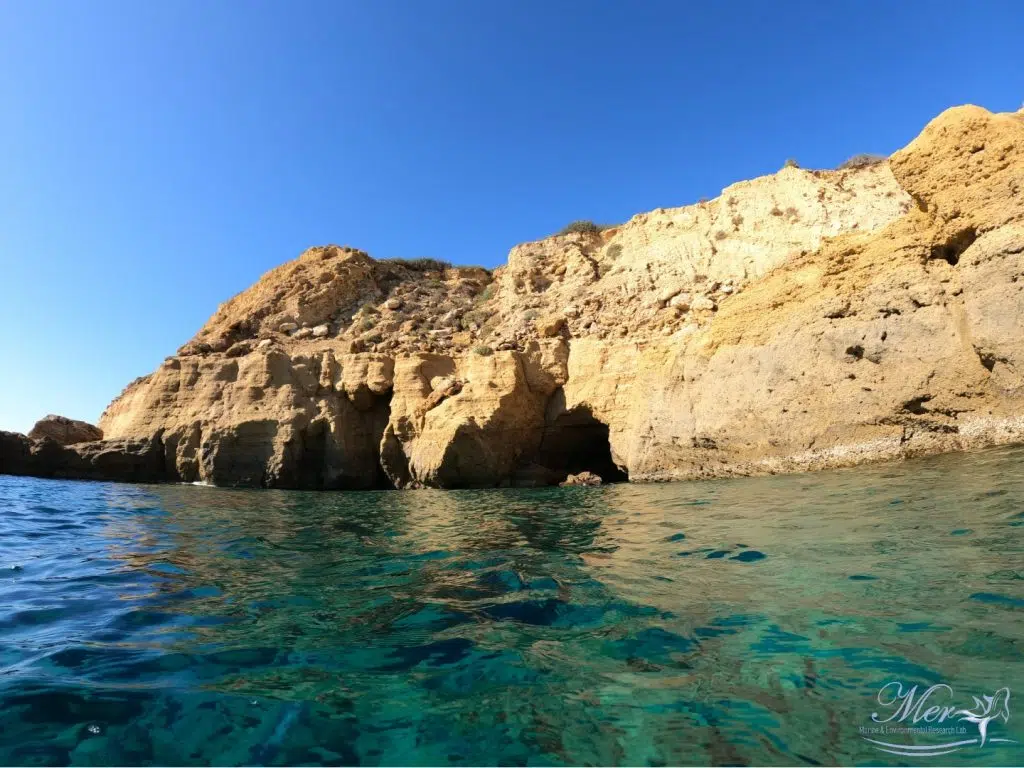
Terrestrial habitats
1210
Annual vegetation of drift lines (Cakiletea maritamae): This habitat is characterized by vegetation formed by annual plants growing on gravel or sand enriched by decomposing organic matter such as seaweed. The main plants are: Cakile maritima, Salsola kali, Medicago litoralis, Euphorbia peplis, Lotus alophilus, Matthiola tricuspidata. This habitat stretches along the sandy and gravelly driftlines of the coasts of the peninsula.
1210
Perennial vegetation of stony banks with Taraxacum: The main plants are: Taraxacum aphrogenes (endemic to Cyprus), Centaurea aegialophila, Limonium sinuatum, Malcolmia nana, Matthiola tricuspitata, Medicago marina. This habitat is present along the western coast of the peninsula.

1240
Vegetated Sea cliffs of the Mediterranean coasts with endemic Limonium spp: The main plants are: Crithmum maritimum, Limonium echioides, Limonium sinuatum, Limonium virgatum, Cichorium spinosum, Convolvulus oleifolius, Echium angustifolium, Euphorbia cassia subsp. cassia, Silene sedoides. Behind this zone there is often a transitional zone with mixed phryganic (Thymus capitatus) and aerohalophilic communities. This habitat is found at places along the southern and western coast of the Akrotiri peninsula.
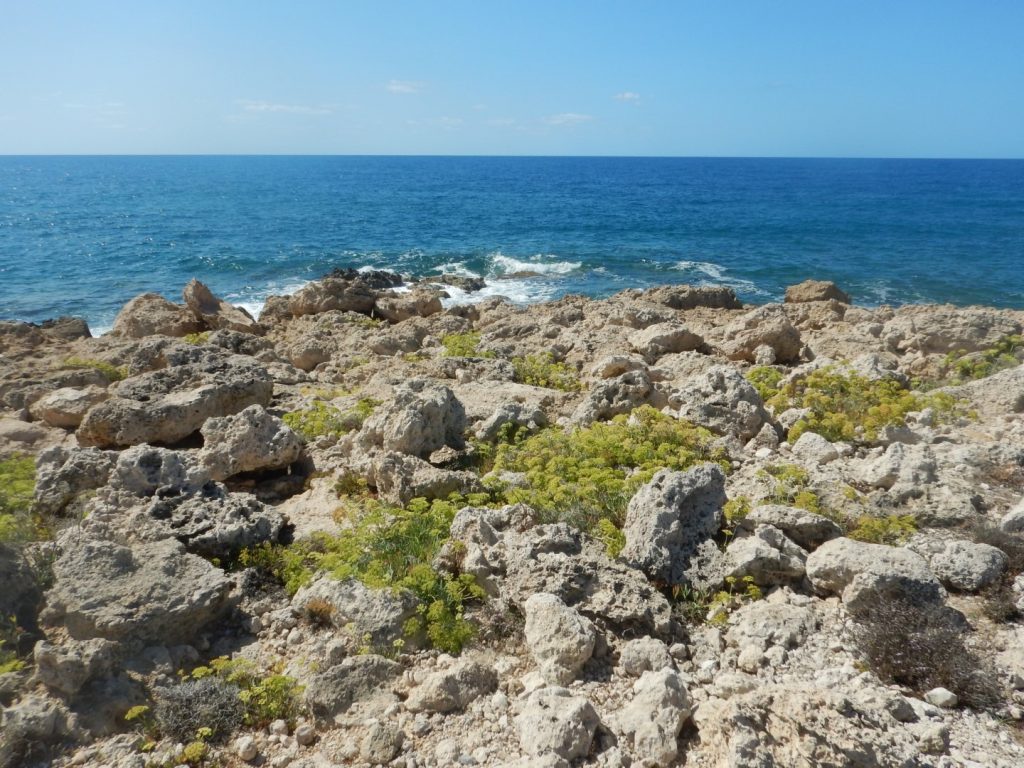
1310
Salicornia and other annuals colonizing mud and sand (Thero-salicornietea and Saginetea maritimae): This habitat is characterized by formations composed mostly or predominantly of annuals, in particular Chenopodiaceae of the genus Salicornia or grasses, colonising periodically inundated muds and sands of marine or interior salt marshes. The main plants are Salicornia europaea, Halopeplis amplexicaulis, Sueda maritima, Cressa cretica, Frankenia pulverulenta, Hordeum marinum, Parapholis marginata, Sphenopus divaricatus, Spergularia marina. This habitat is found at the margins of the Salt Lake and lagoons at the northeastern part of Akrotiri.
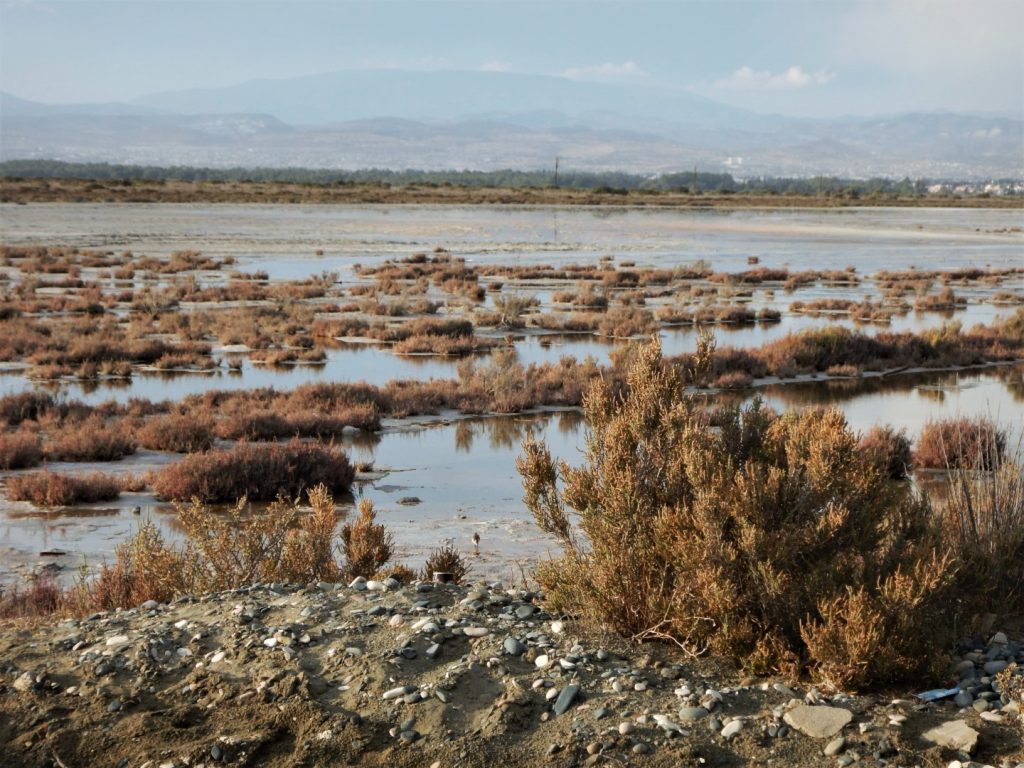
1410
Mediterranean salt meadows (Juncetea maritimi – Juncetalia maritimi): This habitat includes saltmarshes in the Mediterranean basin dominated by Juncus (rushes) especially Juncus maritimus (sea rush) tolerant of saline soils. The main plants are: Juncus maritimus, Juncus accutus, Juncus articulatus, Juncus heldreichianus, Juncus hybridus, Juncus littoralis, Juncus rigidus, Juncus subulatus, Aeluropus lagopoides, Agropyron elongatum, Bolboschoenus maritimus, Carex distans, Carex divisa, Carex extensa, Centaurium pulchellum, Centaurium tenuiflorum, Crypsis factorovskyi, Hordeum marinum, Imperata cylindrica, Limonium mucronulatum, Linum maritimum, Parapholis marginata, Plantago maritima subsp. crassifolia, Saccharum ravennae, Schoenoplectus littoralis, Schoenus nigricans, Scirpoides holoschoenus, Triglochin bulbosa.
1420
Mediterranean halophilous scrubs (Arthrocnemetalia fruticosi): This scrubby, halophilous (i.e. salt-tolerant) vegetation develops in the uppermost levels of saltmarshes, often where there is a transition from saltmarsh to dunes, or in some cases where dunes overlie shingle. The main plants are: Arthrocnemum macrostachyum, Salicornia fruticosa, Salicornia perennis, Halimione portulacoides, Halocnemum strobilaceum, Inula crithmoides, Spergularia marina, Sueda vera, Limonium, mucronulatum. Within this habitat a community of low fixed sand dunes, dominated by Arthrocnemum macrostachyum occurs. This habitat is present at the salt marshes and meadows around the lake.
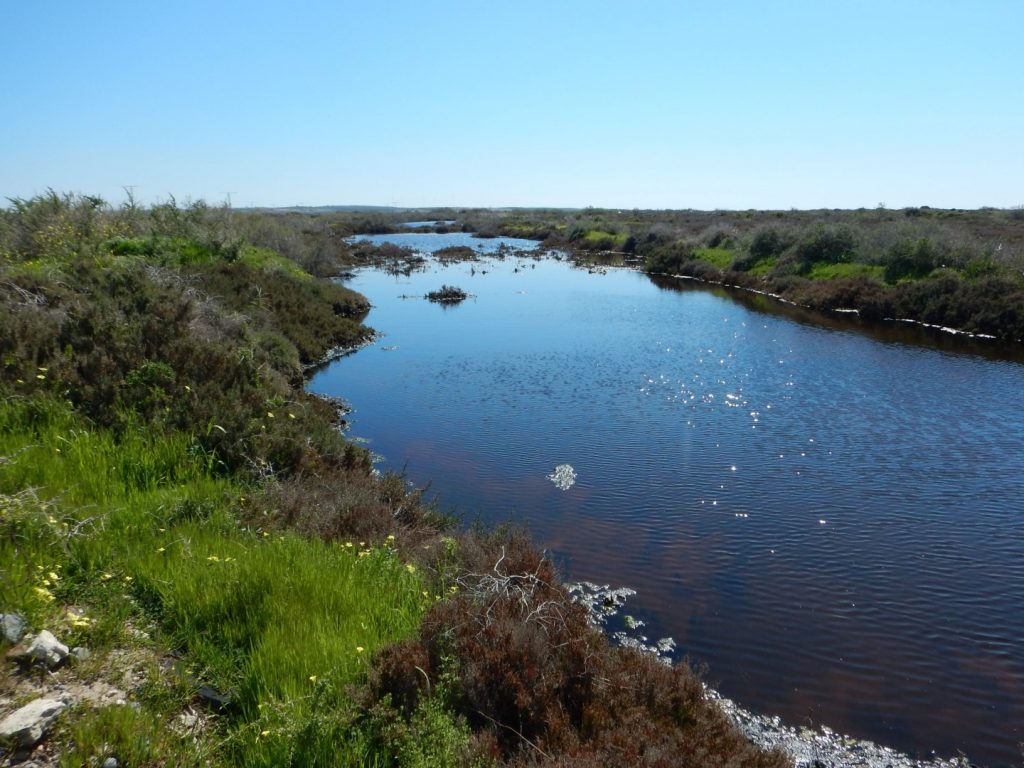
2110
Embryonic shifting dunes. Embryonic shifting dune vegetation exists in a highly dynamic state and is dependent on the continued operation of physical processes at the dune or beach interface. It is representing the first stages of dune construction, constituted by ripples, or raised sand surfaces at the top of the beach. The main plants are: Otanthus maritimus, Agropyron junceum, Cyperus capitatus, Eryngium maritimum, Medicago marina, Pancratium maritimum and Sporobolus virginicus.
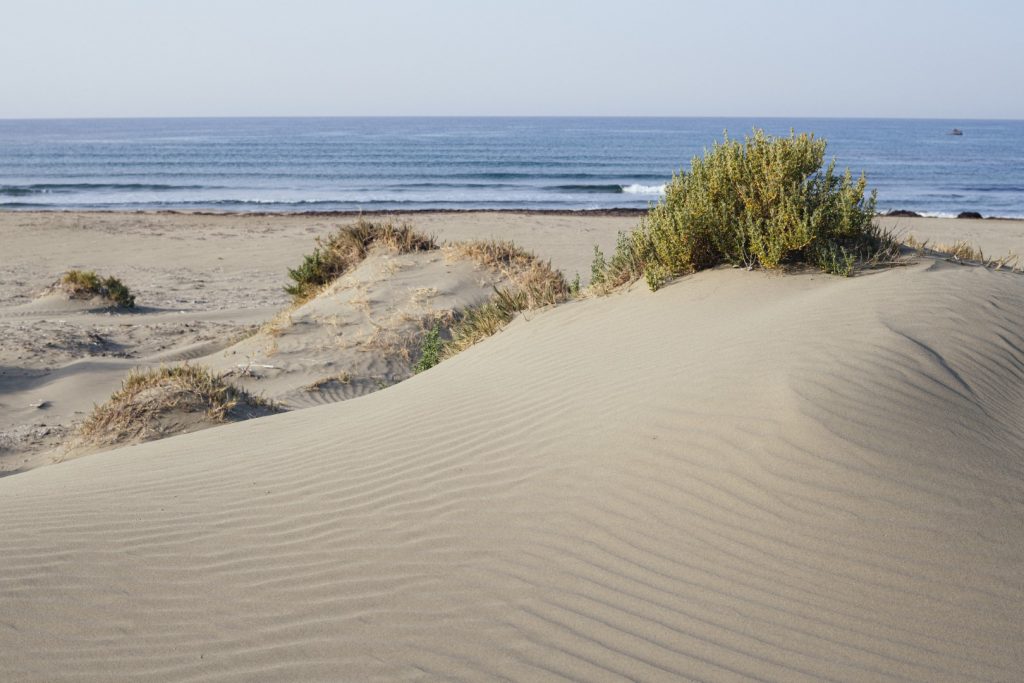
2120
Shifting dunes along the shoreline (white dunes). This habitat encompasses most of the vegetation of unstable dunes where there is active sand movement. These dunes occupy: (i) part of Episkopi bay with special characteristic that the dominant fixing species is Zygophyllum album, while the other species are Medicago marina, Asparagus stipularis, Sporobolus virginicus, Centaurea aegialophila; (ii) part of Limassol bay where at some places the characteristic is that the dominant fixing species are Saccharum ravennae and Imperata cylindrica, while other species are Medicago marina, Pancratium maritimum, Zygophyllum album, Agropyron junceum, Lotus cytisoides, Asparagus stipularis, Centaurea aegialophila and Eryngium maritimum.
2190
Humid dune slacks: Humid dune slacks represent the wetland component of dune systems, appearing as flat valleys in the dunes and are closely associated with high water tables with low nutrient levels. Dune slacks are low-lying areas within dune systems that are seasonally flooded and have low nutrient levels. The main species are: Plantago maritima subsp. crassifolia, Juncus spp., Saccharum ravennae. Humid dune slacks occupy small patches of the dune system at Limassol Bay within the Bishop’s Farm area.
2230
Malcolmietalia dune grasslands: This habitat is formed by vegetation dominated by annual pioneer species of dry depressions in dune systems. The main species are: Malcolmia nana, Pseudorlaya pumila, Silene colorata, Valantia hispida. This habitat occupies patches of the dune system at Limassol Bay.
2240
Brachypodietalia dune grasslands with annuals: Open, dry perennial dune grasslands. These grasslands, host many therophytes-annual plants which survive the unfavourable season as seeds. This habitat occupies patches of the dune systems within habitat types 2250 and 2260. The main species are: Trachynia distachya, Aegilops bicornis, Brassica tournefortii, Hedysarum spinosissimum, Silene colorata, Vulpia membranacea, Tuberaria guttata, Parapholis marginata and Silene discolor.
2260
Dune sclerophyllous scrubs: Within this habitat type three plant communities are recognized: a) Thymus capitatus, Teucrium micropodioides, Helianthemum stipulatum, Cistus spp., Echium angustifolium, Fumana thymifolia, which occurs near salt marshes b) Pistacia lentiscus, Asparagus stipularis, Rhamnus oleoides subsp. graecus, Helianthemum stipulatum, which occurs near salt marshes with special characteristic that the dominating species is Pistacia lentiscus c) On flat encrusted sand along the western coast a distinct community occurs with: Thymelaea hirsuta, Lycium sweinfurthii, Noaea mucronata, Phagnalon rupestre, Echium angustifolium. This community deviates from the typical ones of the habitat and merits further investigation and special treatment.
3140
Hard oligo-mesotrophic waters with benthic vegetation of Chara formations: This habitat is characterized by lakes and pools with waters rich in dissolved bases (pH often 6-7) or with mostly blue to greenish, very clear, waters that are usually poor in nutrients. The bottom of these unpolluted water bodies is covered with charophytes, Chara sp. and Nitella sp., algal carpets. This habitat type is found in few places at Fassouri marsh.
5210
Juniperus phoenicea arborescent matorral: Mediterranean and sub-Mediterranean evergreen sclerophyllous scrub organized around arborescent junipers and specifically Juniperus phoenicea. The main plants are: Juniperus phoenicea, Ceratonia siliqua, Cistus spp., Myrtus communis, Olea europaea, Pistacia lentiscus, Prasium majus, Rhamnus oleoides subsp. graecus, Thymus capitatus, Thymelaea hirsuta.
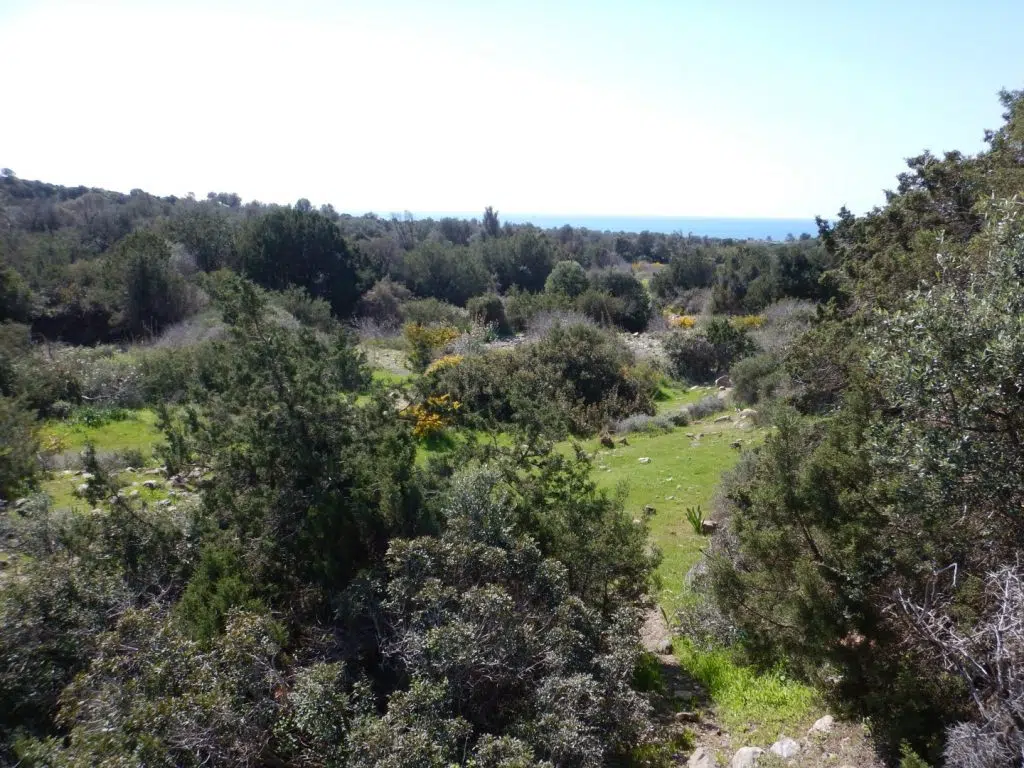
5420
Cisto-Micromerietea phrygana: Low, thorny formations of hemispherical shrubs of the coastal thermo-Mediterranean zone. The main plants are: Sarcopoterium spinosum, Thymus capitatus, Cistus spp., Convolvulus oleifolius, Fumana spp., Helianthemum obtusifolium, Helianthemum spp., Helichrysum conglobatum, Lithodora hispidula subsp. Versicolor, Micromenia spp., Noaea mucronata, onosma fruticosa, Phagnalon rupestre, Teucrium spp. The following formations are included in this habitat type: a) Sarcopoterium spinosum phrygana, b) Thymus capitatus phrygana, c) the rare Thymelaea hirsuta phrygana. Of special interest are the degraded and dwarf phrygana dominated by Schoenus nigricans that form distinct communities within this habitat at several areas of the site.
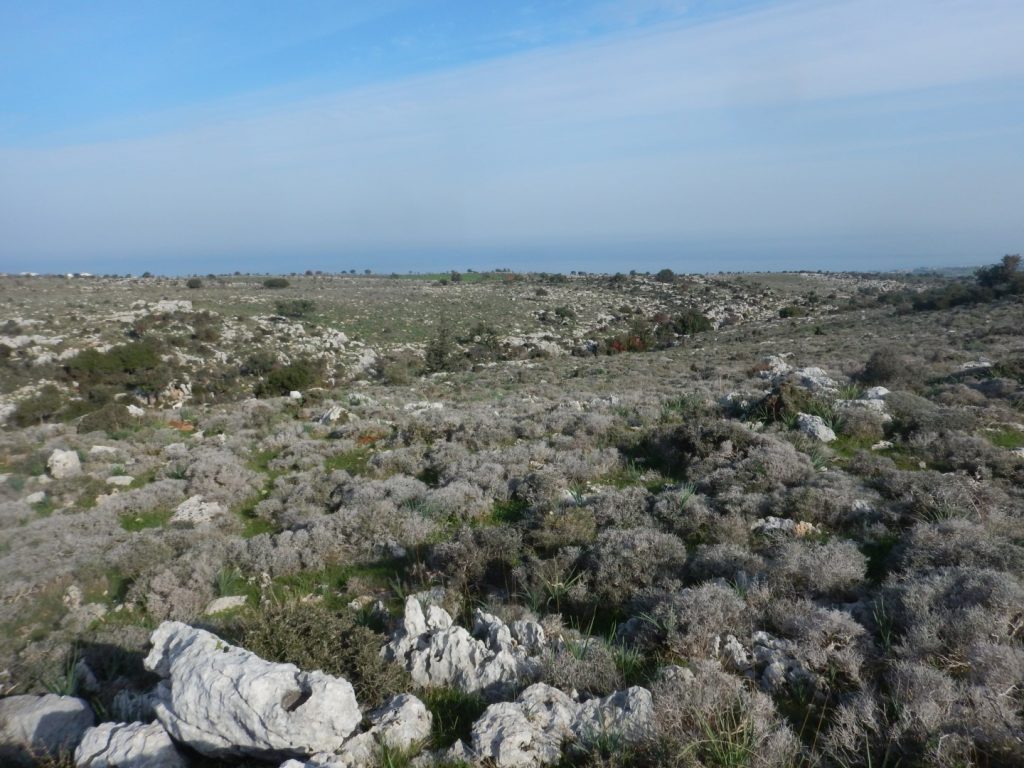
6420
Mediterranean tall-herb and rush meadows (Molinio-Holoscoenion): This habitat is characterized by humid grasslands formed by tall grasses and rushes, often associated with coastal dunes. The main species are: Panicum repens, Baldellia ranunculoides, Teucrium scordium subsp. scorpioides, Centaurea calcitrapa subsp. angusticeps, Cyperaceae spp., Juncus spp., Lotus corniculatus, Lythrum junceum, Mentha aquatica, Ononis spinosa, Pulicaria dysenderica subsp. Uliginosa, Ranunculus peltatus, Saccharum ravennae, Schoenus nigricans, Scirpoides holoschoenus and Euphorbia pubescens. These occur at Fassouri marsh.
92DO
Thermo-Mediterranean riparian galleries (Nerio-Tamariceteae): This habitat is characterized by tamarisk, oleander, and chaste tree galleries and other similar low ligneous formations. Usually found at permanent or temporary streams and wetlands. The main plants are: Tamarix tetragyna, Asparagus stipularis. This habitat is found mainly at the north and north-western part of Akrotiri.
9320
Olea and Ceratonia forest: Thermo-Mediterranean woodland dominated by arborescent Olea europaea ssp. sylvestris, Ceratonia siliqua, Pistacia lentiscus, Myrtus communis.
9540
Mediterranean forests with endemic Mesogean pines: These are found at some parts of the site with main plants: Pinus brutia, Pistacia lentiscus, Cistus spp., Juniperus phoenicea, Lithodora hispidula subsp. versicolor, Myrtus communis, Pistacia terebinthus, Rhamnus oleoides subsp. graecus, Thymus capitatus.
CY02
Reed beds and sedges: This habitat is characterized by reedbed and sedge communities (northern and north-western parts of the site) of the class Phragmito Magnocaricetea. This habitat is important as it provides habitat to many birds. The main plants are: Phragmites australis, Imperata cylindrica, Calystegia sepium, Cladium mariscus, Saccharum ravennae, Juncus spp. and Scirpus maritimus This habitat can be found around Makria lake.
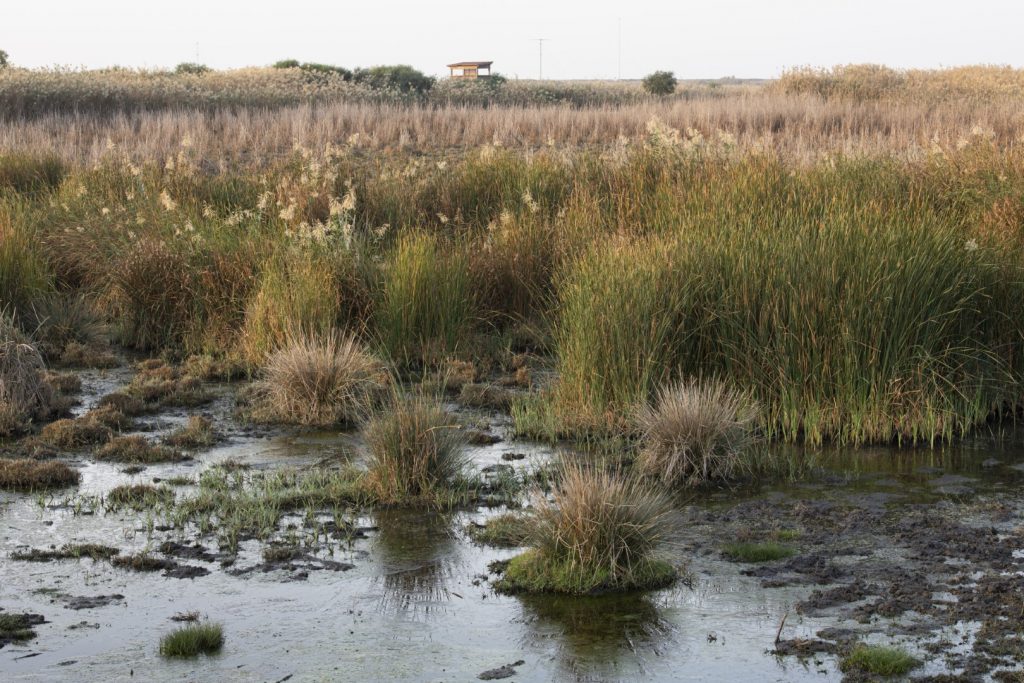
CY05
Sand beaches: This habitat type can be found on the front line of sandy coasts, devoid of vegetation or with sparse vegetation of driftline communities. Sand beaches provide important turtle nesting grounds.
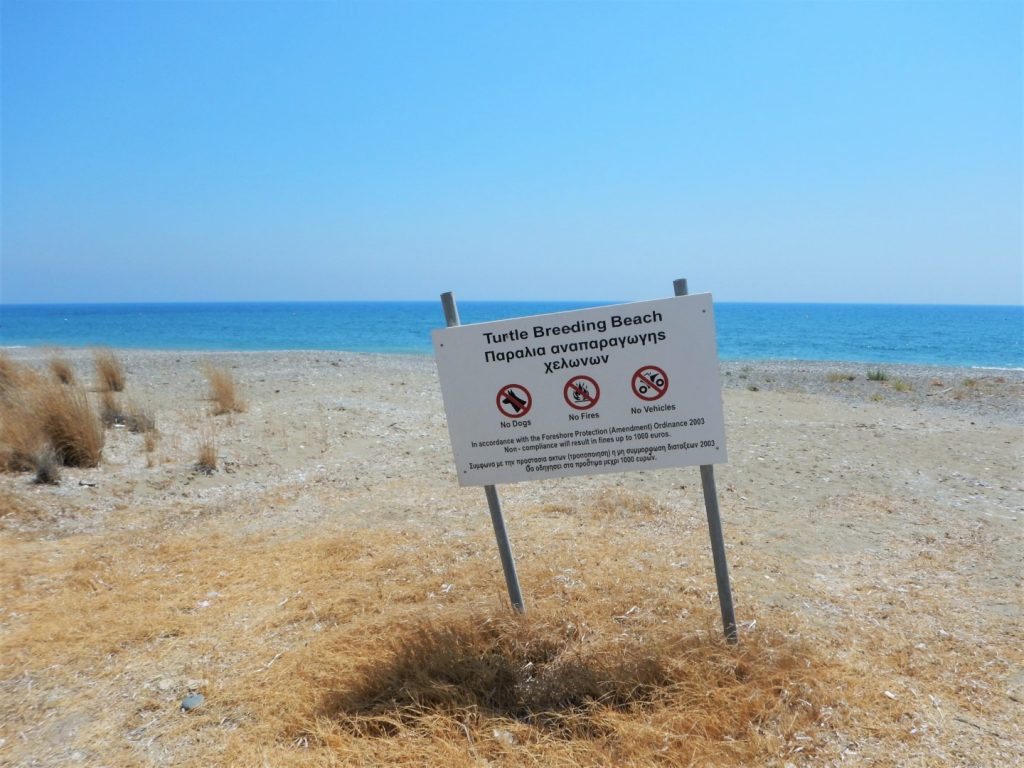
Sandflats
This habitat is characterized by sandy areas with seasonal inundation with sparse or no vegetation. It is an important habitat to small waders during seasons when the water levels are higher within the Salt Lake. It also plays a significant contribution to the formation of thermals during drier periods. Sandflats form an area connecting the Salt Lake to the sea on a seasonal basis.